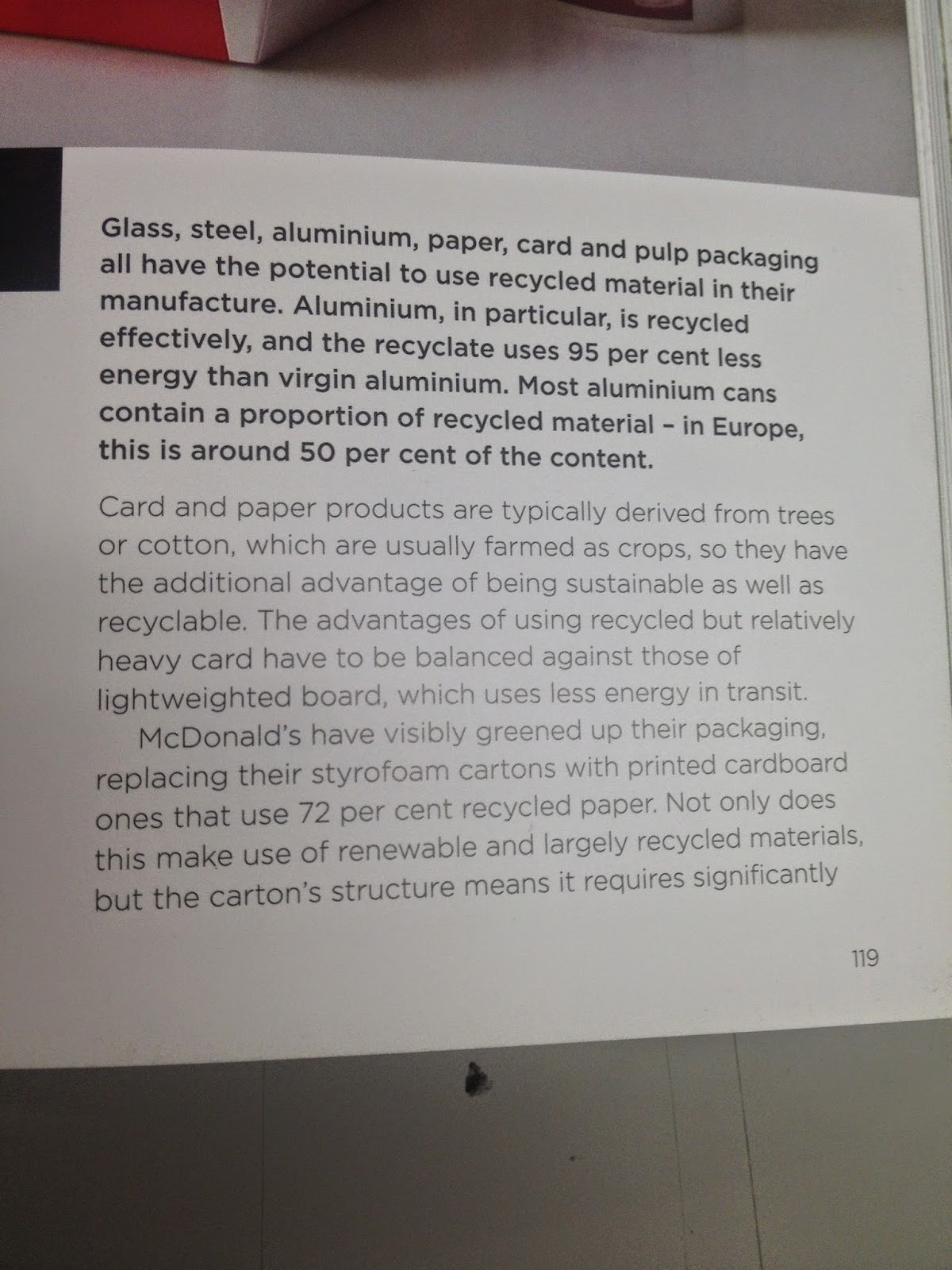Another section from the book 'Why Shrink a Cucumber: The complete guide to environmental packaging', discussing how some of the best packaging are the simplest, and how companies use too much packaging on their products. Functions of packaging should be considered, and that reducing the content could be more suitable along with reducing the space around it.
What Is Design Ethics?
Design Ethics is where moral dilemmas are taken into action and decided upon. They are based on personal beliefs and values within society. External aspects need to be taken into consideration when designing for a client, and that the design should be suitable specifically for them. Designers need to keep various areas in mind, from environmental, multiculturalism to anti-consumerism etc.
Wednesday, 30 April 2014
Breakdown of Ethical Dilemmas in Packaging by Paula Fitzgerald Bone and Robert J. Corey
This research is all collected in the paper "Ethical Dilemmas in Packaging". Although the research on this essay is dated the examples it uses are still relevant today
According to the Natural Marketing Institute’s (NMI), Harleysville, PA, annual U.S. LOHAS Consumer Trends Study, a study performed in 2013. Over packaging is becoming a concern to consumers and more companies may have to look to sizing down their packaging sizes and use more greener products to attract new customers. (Article on the study)
Journal excerpts from: Green Purchasing Strategies: Trends and Implications by Hokey Min and William P. Galle
To help answer these questions, a survey questionnaire was developed for selected industry groups which are heavy producers of scrap and waste materials. These industries include chemicals (26.6 percent of the responding firms), food (12.3 per- cent), printing (9.8 percent), paper (9.2 percent), oil/gas extraction (6.7 percent), textiles (3.9 percent), furniture (3.9 percent), petroleum refineries (2.9 per- cent), lumber (2.5 percent), apparel (1.9 percent), and others (20 percent). From this sample, a total of 527 responses were received, a response rate of 17.6 per- cent.
Most of the respondents (84.4 percent) indicated that they have participated in some form of green purchasing initiative. As shown in Table I, the most important influences on supplier selection are potential liability, followed by cost associated with the disposal of hazardous material, and compliance with state and federal environmental regulations. The importance of the factors may stem from fear of liability litigation and fines and subsequent negative publicity.
Purchasing can enhance the effectiveness of a source reduction strategy in a number of ways such as:
- Reducing the purchased volume of items that are difficult to dispose of or are harmful to the ecosystem
- Reducing the use of hazardous virgin materials by purchasing a higher percentage of recycled or reused content
- Requiring that suppliers minimize unnecessary packaging and use more biodegradable or returnable packaging
In this study, respondents were asked to indicate the frequency of use of three strategies which could be used to reduce the sources of upstream waste. These results are shown in Table IIA.
Survey results indicate that 73.8 percent of the respondents either frequently or somewhat frequently use recycling for source reduction. This may be due in part to the more than 400 solid waste and recycling laws enacted by state governments in the United States.
Monday, 28 April 2014
Recyclable Packaging Design
Within the book 'Why Shrink a Cucumber: The complete guide to environmental packaging', there are two double page spreads discussing the different packaging materials that can be recycled and how. I found that even McDonald's have improved their packaging to create it biodegradable, due to the fact that cards that come in contact with food cannot be recycled.
Wednesday, 23 April 2014
'The Greatest Movie Ever Sold'
'The Greatest Movie Ever Sold' is a 2011 film directed by Morgan Spurlock discussing product placement within everyday media, specifically through the medium of film. This film (Which was funded through Advertising) examines how we constantly consume advertisements everywhere and how brands can be instantly recognisable.
Sunday, 20 April 2014
No Logo
There's a bad mood rising against the corporate brands. No Logo is the warning on the label.
First published in 1999, No Logo by Naomi Klein gives an analysis of our branded world. It specifies on the corporate takeover, by well known brands such as Nike, Gap and Chanel, and how they brand our lifestyles with a simple logo.
Thursday, 17 April 2014
Biotic Baking Brigade Found Footage
Whilst researching further into BBB, I discovered footage online of the activists throwing a few pies at Mayor Willie Brown in 1998 during a 'Clean-Up' event in Bayview/Hunter's Point.
Anti-Consumerists: Biotic Baking Brigade
Biotic Baking Brigade are a network of bakers who pie the faces of public figures. They stand for ecology, human-scale economies, bioregionalism and proper gastronomics. Famous victims of their attacks include Bill Gates and many US city mayors,
"Pieing doesn’t replace other forms of action, but it is a creative tool in a toolbox of resistance to corporate crime. People are sick to death of writing letters, voting, complaining and just being ignored."
Sunday, 13 April 2014
Friday, 11 April 2014
Tuesday, 1 April 2014
Adbusters, the anti-consumerist organization
Adbusters are a non-profit, anti-consumerist organisation. International campaigns launched by them include Buy Nothing Week, TV Turnoff Week and Occupy Wall Street. They are known for their spoof of popular advertisements, and will often modify billboards, such as the Nike advertisement featuring Tiger Woods called 'Swoosh', where they distorted his face into the Nike symbol showing he's their product. They also take part in google bombing and flash mobs.
Subscribe to:
Comments (Atom)






















